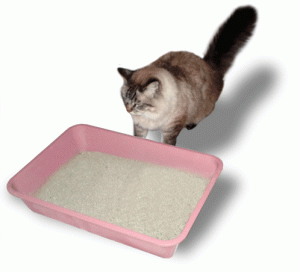|
Cat Litter Box Training Cat Litter box training is very important but first, let me say again, because it’s worth repeating -If your cat suddenly stops using the litter box, he could be in serious trouble. Frequent urination in small amounts, avoiding the litter box, or straining (taking a long time to leave a tiny amount of urine), could indicate a serious medical condition. How NOT to begin cat litter box trainingNever punish your cat for not using his litter box. Yelling, scolding or “rubbing his nose in it” do not work and only make things worse. These are cats we’re talking about, not dogs and they are extremely sensitive to their environment and the attitudes of their humans. A little understanding goes a long way in training a cat. Be prepared for accidents to happen, because they inevitably will. Have on hand a good enzymatic pet urine stain and odor remover, and use it generously when a mistake does occur. Cat litter box training is usually pretty easy, it just requires patience and understanding.
When choosing a new litter or beginning cat litter box training, remember that each cat will develop their own preference in litter. When in doubt, start with an unscented clumping litter. Keep the box filled with at least two inches of litter, but not enough to make your cat feel like he’s in quicksand. When changing brands of litter, it’s usually best to do so gradually. 
Which Litter Box To Use?Cat litter box training begins with the right equipment and supplies. Some cats don't care for covered litter boxes. In fact most cats hate them. If you must use a covered box, remember to scoop and clean often, as odors can be trapped inside. Nice for you, not so nice for your cat, whose sensitive nose will eventually tell him to go elsewhere.
If your cat has nothing but the covered litter box to use, he may also exhibit unusual behavior such as prolonged scratching while in the box. This is his attempt to cover his odor, and unfortunately, in a covered environment, the smell builds up and no amount of scratching will help.
Adding perfumey litter box deodorizers is not the answer either, since many cats hate strong odors to begin with. Think of a port-o-potty....with a strong smelling deodorizer trapped inside there with you....in summertime. Please don't subject your kitty to these conditions. Simply buy a big, open box, and scoop it regularly. It is part of the responsibility we take on when we live with a cat. Some cat owners like automatic-cleaning litter boxes, others don't. While more expensive, they are much less labor intensive and hopefully, if you do invest in one, your cat will comply and use it. Such devices usually come with instructions on how to help your cat become accustomed to the new system.
Size does matter! A proper size litter box will be at least 1 ½ times the length of your cat, including tail! May sound excessive, but this is for the comfort of your cat. He will also be a lot more likely to use his box if he doesn’t feel crowded. I’ve found that long flat plastic storage boxes like you find at the neighborhood “super Center” work great and cost about half of what the smaller pet store litter boxes cost. Try it; I’m sure you and your cat will be pleased! Another advantage to the larger, deeper litterboxes is greatly reduced litter scattering.
Clean, clean, clean! Your part of cat litter box training is to scoop clumping litter at least once a day. My rule of thumb is you can never clean your cat’s litter box too often, so when in doubt, scoop it out! Wash the litter box and replace the litter every week, two at the max. There are some very good enzymatic cleaners and pet odor eliminators that are wonderful for this purpose as well as for cleaning up any little misses that may happen from time to time. Be sure to follow directions on your cleaner and when in doubt be sure to rinse thoroughly. Once you and your cat find a system that works for both of you, stick with it. Monitor Litter Box HabitsKnow your cat's eating, drinking, and bathroom habits, and be alert to any changes. When you scoop, keep an eye on the litter box contents. Occasionally watch your cat in the act, as long as you don't bother him. The urine amount emptied should be more than tiny, with no red tint. Stools should be brown, not immediately hard, and not runny. Once his cat litter box training is complete, your cat should seem comfortable when using the litter box and digging in the litter.
There will of course be natural variations in these behaviors – but if you are in doubt, call your vet. This is one of the most important reasons for keeping cats indoors. You can identify potentially serious urinary conditions by being observant. That’s just not possible with outdoor cats. Special CircumstancesKittens should be introduced to the litter box as early as possible. Cat litter box training, especially kitten training is easy if you can be just a little patient. If your kitten goes anywhere other than the box, wipe up the mess with a paper towel, put the towel in the box, and show your kitten how to cover it up. Keep at it and he'll soon begin to learn. There are also training litters specially formulated to attract your cat or kitten to the litter box, and these have proven to be very helpful in training or even re-training your feline to use the box.
Declawed cats might be more reluctant to dig in the litter, and may require a lighter litter. Clay litter is not good for declawed cats, especially when first declawed. If you have not declawed your cat, please don’t do it! Although many vets still will do this, in my (and many others’) opinion, it is cruel practice and a very unnatural, unhealthy state for your cat. This practice is so barbaric, it is outlawed as abuse in the UK and many other enlightened places. I can only hope the USA will join them soon. Amputating the tips of your beloved cat's toes is NOT the answer! There are many humane alternatives, please consider them.
Older, handicapped, and injured cats will appreciate more and shallower litter boxes, in locations that are easily accessible, e.g. no stairs to climb to reach them. 
Working with your cat and being patient in proper use and maintenance of the litter box will go a long way toward making your cat happier and healthier, and at the same time, help keep your home clean and free of cat odors. If you have any special issues or questions, please don't hesitate to ask me. I will help whenever I can. Ask a question - Send Meow Mail to The Cat Lady! Back from Cat Litter Box Training to Home Page
|






